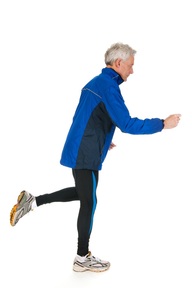Hopping could reduce fracture risk for older men
Just two minutes of hopping a day can strengthen hip bones in older men and reduce the risk of fracture after a fall, a Loughborough University study has found.
The ‘Hip Hop’ study, which measured the effect of daily hopping exercises in 34 men over 65, has found that bone density in the hopping leg improved after just one year.

Dr Sarah Allison, lead researcher at Loughborough University’s National Centre for Sport and Exercise Medicine (NCSEM), said: “Hip fractures are a major public health concern among older adults, incurring both high economic and social costs. Those affected suffer pain, loss of mobility and independence, and increased risk of death.
“We know exercise can improve bone strength and so we wanted to test a form of exercise that is both easy and quick for people to achieve in their homes.”
Researchers suggest that the results could have major implications for future prevention and management of osteoporosis (also known as the fragile bone disease), which affects an estimated three million people in the UK.
Bones thin naturally with age, and localised thinning in the hip is associated with an increased risk of hip fracture. The study has shown that regular exercise can help counteract the effects of ageing to the bone.
Participants of the study performed a series of daily hopping exercises incorporating different multidirectional movements designed to distribute a variation of stresses and strains throughout the proximal femur (hip). Hopping was selected over jumping to ensure comparisons could be made between legs.
CT scans were analysed by a novel bone mapping technique, developed at the University of Cambridge, and showed clear visual differences between the exercise and control legs.
Increases of up to seven per cent were identified in the bone mass of some parts of the outer shell (cortex) and in the density of the layer of spongy bone underneath. There were also improvements in the thinnest areas of the bone most at risk of fracture after a fall.
Dr Winston Rennie, consultant radiologist who supervised the CT scans, commented: “The bone maps show clear changes in bone, with localised adaptions at regions that may be important to reducing hip fracture. Advances in imaging can allow further research in osteoporotic patients to understand the full impact of our findings.”
Commenting further on the results, consultant rheumatologist Dr Ken Poole, who led the bone mapping analysis at Cambridge, added: “In percentage terms, the improvements we saw in these healthy men after just one year of hopping compare favourably to bone gains induced by osteoporosis drugs in women with fragile hips.
"However, we don’t yet know if men and women with osteoporosis would get the same benefits, or even whether the exercises would be safe for them to do, which are important research questions.”
Furthermore, lead researcher at Loughborough University, Dr Katherine Brooke-Wavell, has provided a note of caution. She said: “Our volunteers were screened, and built up the exercises gradually. It is important to exercise carefully, as falling could cause a fracture in someone with weak bones.
“However, over time, our study shows that brief hopping or jumping exercises that target specific regions of the hip, could increase bone strength and reduce the chances of hip fracture.”
The study was funded by a Medical Research Council interdisciplinary bridging award, and the bone mapping analysis by the National Osteoporosis Society.
Latest News
 29-Jul-24
Dementia Bus gives carehome.co.uk staff insight into life with dementia
29-Jul-24
Dementia Bus gives carehome.co.uk staff insight into life with dementia
 01-Mar-24
Find out the top care homes in 2024
01-Mar-24
Find out the top care homes in 2024
 21-Mar-23
UK's top care homes in 2023 revealed
21-Mar-23
UK's top care homes in 2023 revealed
 03-Jan-23
carehome.co.uk launches free care helpline
03-Jan-23
carehome.co.uk launches free care helpline
 13-Dec-22
5 mins with Emily Whitehurst, chief operating officer for Constantia Healthcare
13-Dec-22
5 mins with Emily Whitehurst, chief operating officer for Constantia Healthcare